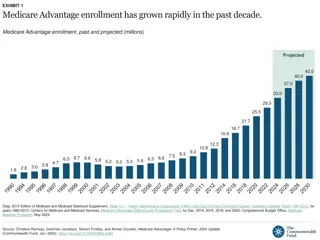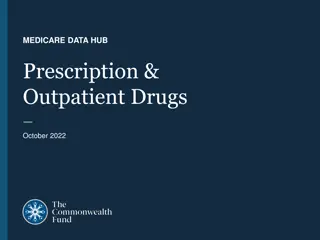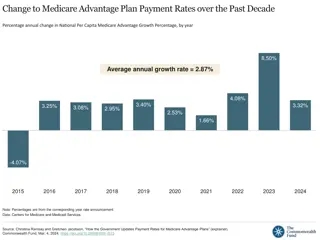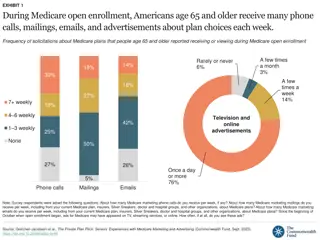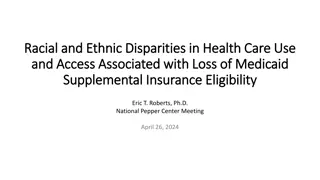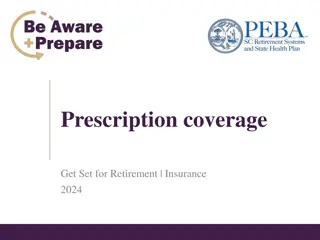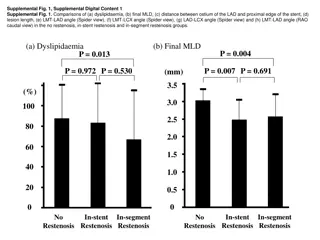International Comparisons of Medicare Programs: October 2021
The international comparisons of Medicare programs in October 2021 reveal key insights into coverage types, affordability, and healthcare costs among older adults in various high-income countries. Private plans in the U.S. offer primary, supplemental, and prescription drug coverage, similar to models in other nations like Germany, Switzerland, and Australia. The data highlights disparities in out-of-pocket costs, with Americans aged 65 and older more likely to face financial barriers to healthcare access compared to their counterparts in other countries. These findings shed light on the challenges and variations in healthcare affordability across different healthcare systems.
Download Presentation

Please find below an Image/Link to download the presentation.
The content on the website is provided AS IS for your information and personal use only. It may not be sold, licensed, or shared on other websites without obtaining consent from the author. Download presentation by click this link. If you encounter any issues during the download, it is possible that the publisher has removed the file from their server.
E N D
Presentation Transcript
MEDICARE DATA HUB International Comparisons October 2021
INTERNATIONAL COMPARISONS In the U.S. Medicare program, private plans offer primary, supplemental, and prescription drug only coverage, similar to models of private plans in other countries. Germany United States Switzerland Netherlands United States Australia France Netherlands Coverage Type United States Canada 2 Source: The Commonwealth Fund/London School of Economics 2020 International Profiles of Health Care Systems, June 2020.
INTERNATIONAL COMPARISONS: AFFORDABILITY A larger share of older adults in Switzerland, the United States, and Australia had high out-of-pocket health care costs compared to other high-income countries. Percent of adults age 65+ who reported out-of-pocket costs of more than USD 2,000 in the past year, by country AUS 19% CAN 12% FRA 4% GER 5% NETH 4% NZ 11% NOR 5% SWE 4% SWIZ 34% UK 4% US 20% Note: Differences between US and all other surveyed countries except AUS were statistically significant at the p < 0.05 level. Data: Commonwealth Fund 2021 International Health Policy Survey of Older Adults. 3
INTERNATIONAL COMPARISONS: AFFORDABILITY Americans age 65 and older were more likely to report postponing or forgoing health care because of the cost than older adults in other high-income countries. Percent of adults age 65+ who reported they skipped doctor visit or medical test/treatment in the past year because of the cost, by country Did not consult/visit a doctor when had a medical problem because of the cost Skipped a medical test or treatment because of the cost 8% 7% 6% 6% 4% 4% 4% 4% 4% 4% 3% 1% 3% 1% 1% 1% 1% 2% 2% 2% 0% 2% Note: Differences in not consulting/visiting a doctor because of the cost between US and all other surveyed countries except AUS and NZ were statistically significant at the p < 0.05 level. Differences in skipping a medical test or treatment because of the cost between US and all other surveyed countries except AUS were statistically significant at the p < 0.05 level. Data: Commonwealth Fund 2021 International Health Policy Survey of Older Adults. 4
INTERNATIONAL COMPARISONS: AFFORDABILITY Americans age 65 and older were more likely to report not filling a prescription or skipping a medication dose because of the cost than older adults in other high-income countries. Percent of adults age 65+ who reported they did not fill a prescription or skipped a dose of medication in the past year because of the cost, by country 9% 4% 3% 1% 1% 1% 1% 1% 2% 2% 2% AUS CAN FRA GER NETH NZ NOR SWE SWIZ UK US Note: Differences between US and all other surveyed countries were statistically significant at the p < 0.05 level. Data: Commonwealth Fund 2021 International Health Policy Survey of Older Adults. 5
INTERNATIONAL COMPARISONS: AFFORDABILITY About one of six older adults in the United States, Australia, Canada, and New Zealand reported skipping a dental visit because of the cost. Percent of adults age 65+ who reported they did not visit the dentist in the past year because of the cost, by country 16% 15% 14% 14% 10% 9% 8% 6% 6% 1% 2% AUS CAN FRA GER NETH NZ NOR SWE SWIZ UK US Note: Differences between US and all other surveyed countries except AUS, CAN, and NZ were statistically significant at the p < 0.05 level. Data: Commonwealth Fund 2021 International Health Policy Survey of Older Adults. 6
INTERNATIONAL COMPARISONS: COVID-19 More older adults in America, especially Black and Hispanic adults, reported negative economic consequences because of the pandemic compared to those in other countries. Percent of adults age 65+ who reported either using up all or most of their savings or losing job/source of income because of the coronavirus pandemic AUS CAN FR GER NETH 14% 15% 8% 3% 5% NZ 11% NOR SWE SWIZ UK 5% 5% 4% 10% US-Total US- White US- Black US-Hispanic 19% 14% 32% 39% Note: Differences between US and all other surveyed countries except AUS were statistically significant at the p < 0.05 level. Within US, differences between white respondents and both Black and Hispanic respondents were statistically significant at the p < 0.05 level. Data: Reginald D. Williams II et al., The Impact of COVID-19 on Older Adults: Findings from the 2021 International Health Policy Survey of Older Adults (Commonwealth Fund, Sept. 2021). https://doi.org/10.26099/mqsp-1695 7
INTERNATIONAL COMPARISONS: COVID-19 Older adults with multiple chronic conditions in the U.S. reported the highest rates of cancelling or postponing medical appointments because of the pandemic compared to those in other countries. Percent of adults age 65+ with at least two chronic conditions 37% 32% 32% 32% 23% 22% 21% 17% 16% 14% 11% AUS CAN FR GER NETH NZ NOR SWE SWIZ UK US Notes: Respondents reported ever being told by a doctor they had at least two of the following conditions: hypertension or high blood pressure; heart disease, including heart attack; diabetes; asthma or chronic lung disease such as chronic bronchitis, emphysema, or chronic obstructive pulmonary disease; depression, anxiety, or other mental health conditions; cancer; joint pain or arthritis; stroke. Differences between US and all other surveyed countries except CAN, NETH, and UK were statistically significant at the p < 0.05 level. Data: Reginald D. Williams II et al., The Impact of COVID-19 on Older Adults: Findings from the 2021 International Health Policy Survey of Older Adults (Commonwealth Fund, Sept. 2021). https://doi.org/10.26099/mqsp-1695 8
INTERNATIONAL COMPARISONS: COVID-19 Among older adults who need help with daily activities, those in Canada, the U.K., the U.S., and Australia reported the highest rates of not receiving needed help because services were cancelled or very limited due to the coronavirus pandemic. Percent of adults age 65+ 31% 30% 23% 21% 16% 16% 16% 13% 13% 11% 8% AUS CAN FR GER NETH NZ NOR SWE SWIZ UK US Notes: Instrumental activities of daily living include housework, preparing meals, managing daily medications, or shopping. NZ and NOR excluded because n < 100. Differences between US and GER, NETH, and SWIZ were statistically significant at the p < 0.05 level. Data: Reginald D. Williams II et al., The Impact of COVID-19 on Older Adults: Findings from the 2021 International Health Policy Survey of Older Adults (Commonwealth Fund, Sept. 2021). https://doi.org/10.26099/mqsp-1695 9
INTERNATIONAL COMPARISONS: COVID-19 Older adults with multiple chronic conditions in Canada, the U.K., Australia, the U.S., the Netherlands, and Sweden reported higher rates of telephone or video appointments with health care professionals in the past year compared to those in other countries. Percent of adults age 65+ with at least two chronic conditions 80% 77% 68% 56% 56% 52% 43% 38% 20% 5% 12% AUS CAN FR GER NETH NZ NOR SWE SWIZ UK US Notes: Respondents reported ever being told by a doctor they had at least two of the following conditions: hypertension or high blood pressure; heart disease, including heart attack; diabetes; asthma or chronic lung disease such as chronic bronchitis, emphysema, or chronic obstructive pulmonary disease; depression, anxiety, or other mental health conditions; cancer; joint pain or arthritis; stroke. Differences between US and all other surveyed countries except NETH and SWE were statistically significant at the p < 0.05 level. Data: Reginald D. Williams II et al., The Impact of COVID-19 on Older Adults: Findings from the 2021 International Health Policy Survey of Older Adults (Commonwealth Fund, Sept. 2021). https://doi.org/10.26099/mqsp-1695 10
INTERNATIONAL COMPARISONS: COVID-19 COVID-19 vaccination rates are high among older adults where vaccines are available. Among the unvaccinated, American older adults report the highest rates of planning to not get vaccinated. Percent of adults age 65+ 8% AUS 20% 63% 4% CAN 78% 16% FR 77% 14% 6% GER 84% 12% 1% Yes, have received vaccine NETH 74% 22% 2% NZ 3% 81% 7% Have not received vaccine and DO plan to get vaccinated NOR 63% 32% 4% Have not received vaccine and DO NOT plan to get vaccinated SWE 30% 62% 2% SWIZ 55% 31% 9% UK 97% 1% 2% US 78% 9% 10% Notes: Not sure responses not shown. Differences between US and all other surveyed countries except CAN, FRA, and NETH for yes, have received vaccine were statistically significant at the p < 0.05 level. Differences between US and all other surveyed countries for have not received vaccine and DO plan to get vaccinated were statistically significant at the p < 0.05 level. Differences between US and all other surveyed countries except AUS, NZ, and SWIZ for have not received vaccine and DO NOT plan to get vaccinated were statistically significant at the p < 0.05 level. Data: Reginald D. Williams II et al., The Impact of COVID-19 on Older Adults: Findings from the 2021 International Health Policy Survey of Older Adults (Commonwealth Fund, Sept. 2021). https://doi.org/10.26099/mqsp-1695 11
INTERNATIONAL COMPARISONS: COVID-19 Concerns about safety and side effects were the most cited reasons older Americans do not plan to get vaccinated. Main reason for not planning to get the coronavirus vaccine, among those who do not plan to get vaccinated when available CAN FR SWE SWIZ US Unweighted N (base: those who do not plan to get the vaccine when available respondents)= 240 155 172 327 219 Do not trust vaccine in general 14% 15% 6%* 12% 14% Worried about possible side effects Do not trust the government to make sure the vaccine is safe 25% 24% 48%* 45%* 22% 17% 28% 15% 8%* 24% It is too difficult to get the vaccine 1% 0% 2% 2%* 0% You do not think you need the vaccine 7% 3%* 1%* 9% 13% Some other reason 25% 22% 17% 18% 20% Notes: Respondents reported ever being told by a doctor they had at least two of the following conditions: hypertension or high blood pressure; heart disease, including heart attack; diabetes; asthma or chronic lung disease such as chronic bronchitis, emphysema, or chronic obstructive pulmonary disease; depression, anxiety, or other mental health conditions; cancer; joint pain or arthritis; stroke. AUS, GER, NETH, NZ, NOR, and UK excluded because n < 100. * Indicates country s result on specific response is statistically different from US at the p < 0.05 level. Data: Reginald D. Williams II et al., The Impact of COVID-19 on Older Adults: Findings from the 2021 International Health Policy Survey of Older Adults (Commonwealth Fund, Sept. 2021). https://doi.org/10.26099/mqsp-1695 12



